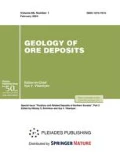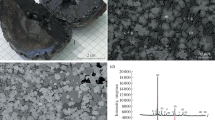Abstract
A new variety of matrices based on synthetic phases whose structure is close to that of murataite (a natural mineral) is proposed for immobilization of nuclear wastes. Murataite is Na, Ca, REE, Zn, and Nb titanate with a structure derived from the fluorite lattice. This very rare mineral was found in alkali pegmatites from Colorado in the United States and the Baikal region in Russia. The synthetic murataite-like phases contain manganese instead of zinc, as well as actinides and zirconium instead of sodium, calcium, and niobium. Varieties with threefold, as in the mineral, and five-, seven-, and eightfold repetition of the lattice relative to the fluorite cell have been established. Correspondingly, the structural varieties M3, M5, M7, and M8 are recognized among the synthetic murataites. A decrease in the contents of actinides, rare earth elements, and zirconium occurs in the series M7-M5-M8-M3, along with enrichment in Ti, Al, Fe, and Ga. Murataite-based ceramics are characterized by high chemical and radiation stability. The rate of U, Th, and Pu leaching with water at 90°C in static and dynamic tests is 10−6–10−5 g/m2 per day. These values are lower than the leaching rate of other actinide confinement matrices, for example, zirconolite-or pyrochlore-based. Murataite is close to other titanates in its radiation resistance. At 25°C, amorphization of its lattice is provided by a radiation dose of 2 × 1018 α decays/g, or 0.2 displacements/atom. Murataite-based matrices are synthesized within a few hours by cold compacting combined with sintering at 1300°C or by melting at 1500–1600°C and subsequent crystallization. The melting technology, including induction smelters with a cold crucible, makes it possible to produce samples with zonal murataite grains. The inner zone of such grains is composed of structural variety M5 or M7; the intermediate zone, of M8; and the outer zone, of M3. The contents of actinides, zirconium, and rare earth elements reach a maximum in the inner zone and drop to a minimum in the outer zone, while the amounts of nonradioactive elements—Ti, Al, Fe, and Ga—vary conversely. The U, Th, and Pu contents in the inner and outer zones differ by three to five times. Such a distribution precludes removal of actinides by interaction of the matrix with solution after its underground disposal. Individual actinides (Np, Pu, Am); the actinide-zirconium-rare earth fraction of high-level radioactive wastes (HLW); Am-Ga residues of weapons plutonium reprocessing with its conversion into U-Pu mixed oxide (MOX) fuel; and other sorts of HLW enriched in actinides, REE, and products of corrosion (Mn, Fe, Al, Zr) can be incorporated into a murataite-based matrix. As much as 350 kg of HLW components can be included in 1 t of such a ceramic. An actinide matrix that is composed of titanates with a pyrochlore structure is its nearest analogue. The advantage of murataite in comparison with pyrochlore consists in its universal character; i.e., a murataite-based matrix can be used for utilization of a wider range of actinide-bearing highly radioactive wastes.
Similar content being viewed by others
References
J. W. Adams, T. Botinelly, W. N. Sharp, and K. Robinson, “Murataite, a New Complex Oxide from El Paso County, Colorado,” Am. Mineral. 59(1/2), 172–176 (1974).
End Points for Spent Nuclear Fuel and High-Level Radioactive Waste in Russia and the United States (National Academic Press, Washington DC, 2003).
T. S. Ercit and F. C. Hawthorne, “Murataite, a UB12 Derivative Structure with Condensed Keggin Molecules,” Can. Mineral. 33, 1223–1229 (1995).
GOST (State Standard) R 50926-96. Solidified High-Level Radioactive Waste. General Technical Requirements (Gosstandart Rossii, Moscow, 1996) [in Russian].
GOST (State Standard) R 52126-2003. Radioactive Waste. Testing of the Chemical Stability of Solidified High-Level Radioactive Waste by Long-Term Leaching (Gosstandart Rossii, Moscow, 2003) [in Russian].
O. V. Karimova, N. I. Organova, and V. G. Balakirev, “Modulation in the Murataite Structure,” Kristallografiya 47(6), 1027–1030 (2002) [Crystallography Reports 47 (6), 957–960 (2002)].
O. I. Kir’yanova, S. V. Stefanovsky, S. V. Yudintsev, and B. S. Nikonov, “The Effect of CaO: Gd2O3 and CaO: UO2 Ratios on the Phase Composition of Ceramics in the CaO-Gd2O3 (UO2)-MnO-TiO2 System,” Perspektivnye Materialy, No. 5, 38–45 (2002).
A. A. Kopyrin, A. I. Karelin, and V. A. Karelin, Technology of Production and Radiochemical Reprocessing of Nuclear Fuel (Atomenergoizdat, Moscow, 2006) [in Russian].
N. P. Laverov, A. I. Gorshkov, S. V. Yudintsev, et al., “New Structural Variations of Synthetic Murataite,” Dokl. Akad. Nauk 363(4), 540–543 (1998a) [Dokl. Earth Sci. 363A (9), 1272–1274 (1998a)].
N. P. Laverov, B. I. Omel’yanenko, S. V. Yudintsev, and B. S. Nikonov, “Zirconolite As a Matrix for Immobilization of High-Level Radioactive Waste,” Geol. Rudn. Mestorozhd. 38(5), 387–395 (1996) [Geol. Ore Deposits 38 (5), 345–352 (1996)].
N. P. Laverov, B. I. Omel’yanenko, S. V. Yudintsev, et al., “Mineralogy and Geochemistry of Matrices for the Immobilization of High-Level Radioactive Waste,” Geol. Rudn. Mestorozhd. 39(3), 211–228 (1997) [Geol. Ore Deposits 39 (3), 179–193 (1997)].
N. P. Laverov, B. I. Omel’yanenko, S. V. Yudintsev, and B. S. Nikonov, “Objectives of Mineralogical Studies in Connection with Radioactive Waste Disposal,” in Proceedings of Conference on Ecological Mineralogy (IGEM, Moscow, 1998b), pp. 5–36 [in Russian].
N. P. Laverov, I. A. Sobolev, S. V. Stefanovsky, et al., “Synthetic Murataite: A New Mineral for Actinide Immobilization,” Dokl. Akad. Nauk 362(5), 670–672 (1998c) [Dokl. Earth Sci. 363 (8), 1104–1106 (1998c)].
N. P. Laverov, S. V. Yudintsev, B. I. Omel’yanenko, et al., “Murataite Ceramics for the Immobilization of Actinides,” Geol. Rudn. Mestorozhd. 41(2), 99–108 (1999) [Geol. Ore Deposits 41 (2), 85–93 (1999)].
N. P. Laverov, S. V. Yudintsev, S. V. Stefanovsky, and Ya. N. Dzhang, “New Actinide Matrix with Pyrochlore Structure,” Dokl. Akad. Nauk 381(3), 399–402 (2001) [Dokl. Earth Sci. 381A (9), 1053–1056 (2001)].
N. P. Laverov, S. V. Yudintsev, S. V. Stefanovsky, et al., “Phase Formation during the Synthesis of Actinide Matrices,” Dokl. Akad. Nauk 383(1), 95–98 (2002) [Dokl. Earth Sci. 383 (2), 190–193 (2002)].
N. P. Laverov, S. V. Yudintsev, T. S. Yudintseva, et al., “Effect of Radioactive Decay on Properties of Confinement Matrices of Actinide-Bearing Waste,” Geol. Rudn. Mestorozhd. 45(6), 483–513 (2003) [Geol. Ore Deposits 45 (6), 423–451 (2003)].
J. Lian, L. M. Wang, R. C. Ewing, et al., “Ion Beam-Induced Amorphization and Order-Disorder Transitions in the Murataite Structure,” J. Applied Physics 97(113536), (2005).
K. Maslakov, A. Teterin, Yu. Teterin, et al., “X-ray Photoelectron Spectroscopy Study of Plutonium-Containing Murataite-Based Ceramics,” in Proceedings of the 36th Journées des Actinides Symposium: Abstract P-22 (Oxford, 2006).
Hj. Matzke and J. van Geel, “Incorporation of Pu and Other Actinides in Borosilicate Glass and Waste Ceramics,” in Disposal of Weapon Plutonium (Kluwer Acad. Publ., 1996), pp. 93–105.
P. E. D. Morgan and F. J. Ryerson, “A New “Cubic” Crystal Compound,” J. Mater. Sci. Lett. 1(8), 351–352 (1982).
A. M. Portnov, L. S. Dubakina, and G. K. Krivokoneva, “Murataite in the Predicted Association with Landauite,” Dokl. Akad. Nauk SSSR 261(3), 741–744 (1981).
A. E. Ringwood, “Disposal of High-Level Nuclear Waste: A Geological Perspective,” Mineral. Mag. 49, 159–176 (1985).
S. V. Stefanovsky, O. I. Kir’yanova, S. V. Yudintsev, et al., “Phase Composition and Distribution of Elements in Murataite Ceramics Containing REE and Actinoids,” Fiz. Khim. Obrab. Mater., No. 3, 72–80 (2001).
S. V. Stefanovsky, B. S. Nikonov, B. I. Omel’yanenko, et al., “Synthetic Molten Zirconolite-Based Materials for Immobilization of Radioactive Waste,” Fiz. Khim. Obrab. Mater., No. 6, 111–117 (1997).
S. V. Stefanovsky, S. V. Yudintsev, and O. I. Kir’yanova, “The Effect of Synthesis Conditions on the Phase Composition of Pyrochlore-Brannerite Ceramics,” Fiz. Khim. Obrab. Mater., No. 5, 90–98 (2001).
S. V. Stefanovsky, S. V. Yudintsev, B. S. Nikonov, and B. I. Omel’yanenko, “A Study of SYNROC Material,” Geoekology, No. 4, 58–74 (1996).
S. V. Stefanovsky, S. V. Yudintsev, B. S. Nikonov, and O. I. Stefanovskaya, “Phase Composition of Ceramics in Systems with Rare Earth Elements, Manganese, and Titanium Oxides,” Radiokhimiya 48 (2006) [Radiochemistry 48 (2006)] (in press).
D. M. Strachan, R. D. Scheele, E. C. Buck, et al., “Radiation Damage Effects in Candidate Titanates for Pu Disposition: Pyrochlore,” J. Nucl. Mater, No. 345, 109–135 (2005).
V. S. Urusov, N. I. Organova, O. V. Karimova, et al., “Synthetic “Murataites” As Modular Members of the Pyrochlore-Murataite Polisomatic Series,” Dokl. Akad. Nauk 401(2), 226–232 (2005) [Dokl. Earth. 401 (2), 319–325 (2005)].
V. S. Urusov, V. S. Rusakov, and S. V. Yudintsev, “Valence State and Structural Position of Fe Atoms in Synthetic Murataite,” Dokl. Akad. Nauk 384(4), 527–532 (2002) [Dokl. Earth Sci. 384 (4), 461–465 (2002)].
E. R. Vance, B. D. Begg, R. A. Day, and C. J. Ball, “Zirconolite-Rich Ceramics for Actinide Waste,” in Proceedings of Symposium on Scientific Basis for Nuclear Waste Management XVIII (MRS, Pittsburgh, 1995), Vol. 353, pp. 767–774.
Yu. F. Volkov, S. V. Tomilin, A. N. Lukinykh, et al., “Titanate Ceramics with Pyrochlore Structure As a Matrix for Immobilization of Excess Weapons-Grade Plutonium,” Radiokhimiya 46(4), 322–328 (2004) [Radiochemistry 46 (4), 351–357 (2004)].
W. J. Weber and R. C. Ewing, “Radiation Effects in Crystalline Oxide Host Phases for the Immobilization of Actinides,” in Proceedings of Symposium on Scientific Basis for Nuclear Waste Management XXV (MRS, Warrendale, 2002), Vol. 713, pp. 443–454.
W. J. Weber, J. W. Wald, and Hj. Matzke, “Effects of Self-Radiation Damage in Cm-Doped Gd2Ti2O7 and CaZrTi2O7,” J. Nucl. Mater. 138, 196–209 (1986).
S. V. Yudintsev, “A Structura-Chemical Approach to Selecting Crystalline Matrices for Actinide Immobilization,” Geol. Rudn. Mestorozhd. 45(2), 172–187 (2003) [Geol. Ore Deposits 45 (2), 151–165 (2003)].
S. V. Yudintsev, S. V. Stefanovsky, B. S. Nikonov, and B. I. Omelianenko, “Phase and Chemical Stability of Murataite Containing Uranium, Plutonium and Rare Earth’s,” in Proceeding of Symposium on Scientific Basis for Nuclear Waste Management XXIV (MRS, Warrendale, 2001), Vol. 663, 357–366.
Author information
Authors and Affiliations
Corresponding author
Additional information
Original Russian Text © N.P. Laverov, S.V. Yudintsev, S.V., Stefanovsky, B.I. Omel’yanenko, B.S. Nikonov, 2006, published in Geologiya Rudnykh Mestorozhdenii, 2006, Vol. 48, No. 5, pp. 387–409.
Rights and permissions
About this article
Cite this article
Laverov, N.P., Yudintsev, S.V., Stefanovsky, S.V. et al. Murataite as a universal matrix for immobilization of actinides. Geol. Ore Deposits 48, 335–356 (2006). https://doi.org/10.1134/S1075701506050011
Received:
Issue Date:
DOI: https://doi.org/10.1134/S1075701506050011




